Comparative Cost Accounting Analysis: Sewing Ltd. Case Study
VerifiedAdded on 2021/06/16
|15
|3180
|27
Report
AI Summary
This report provides a comprehensive analysis of cost accounting methods, specifically focusing on the comparison between traditional costing and activity-based costing (ABC). The analysis uses a case study of Sewing Ltd. to illustrate the practical implications of each method. The report begins by c...
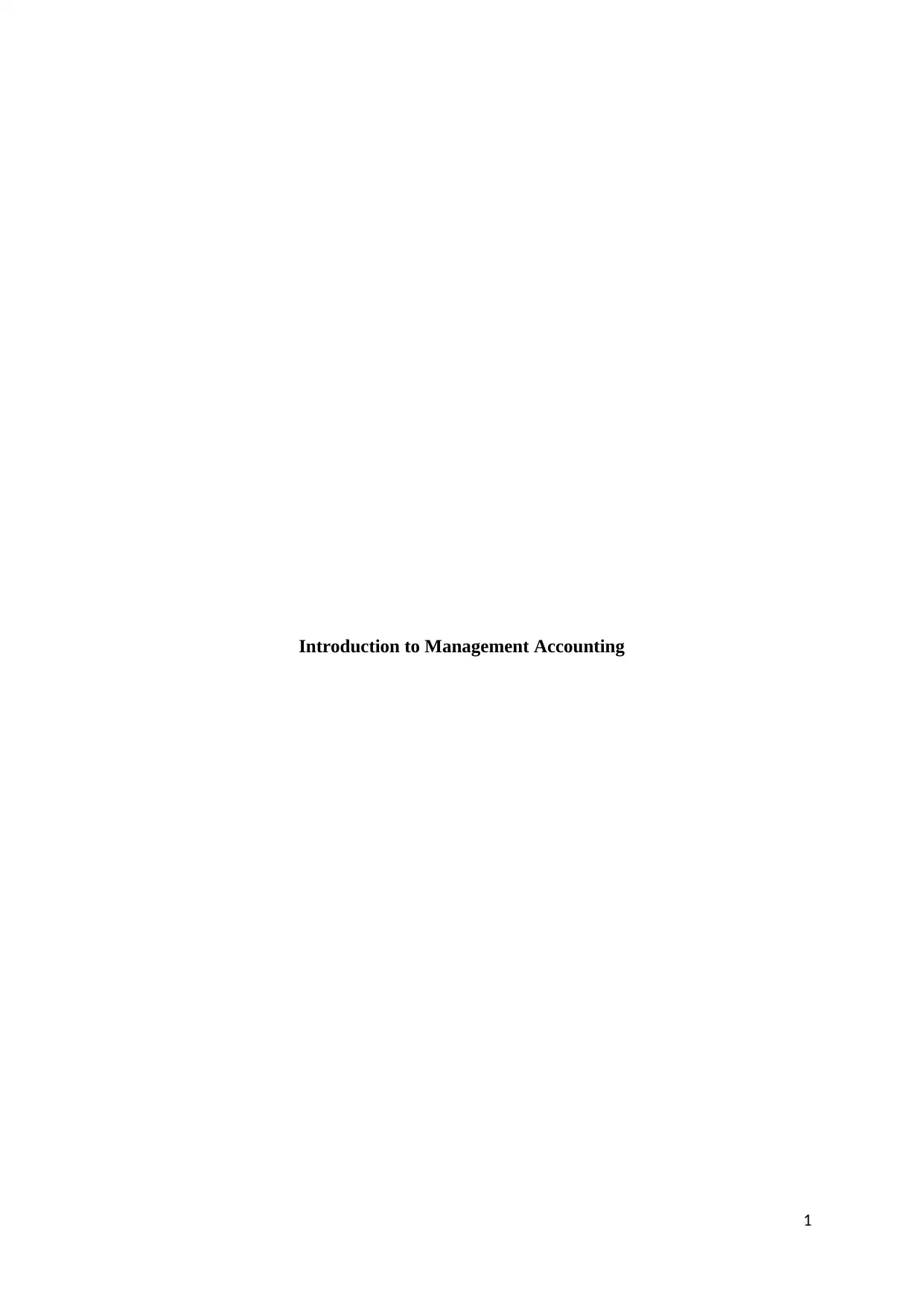
Introduction to Management Accounting
1
1
Paraphrase This Document
Need a fresh take? Get an instant paraphrase of this document with our AI Paraphraser
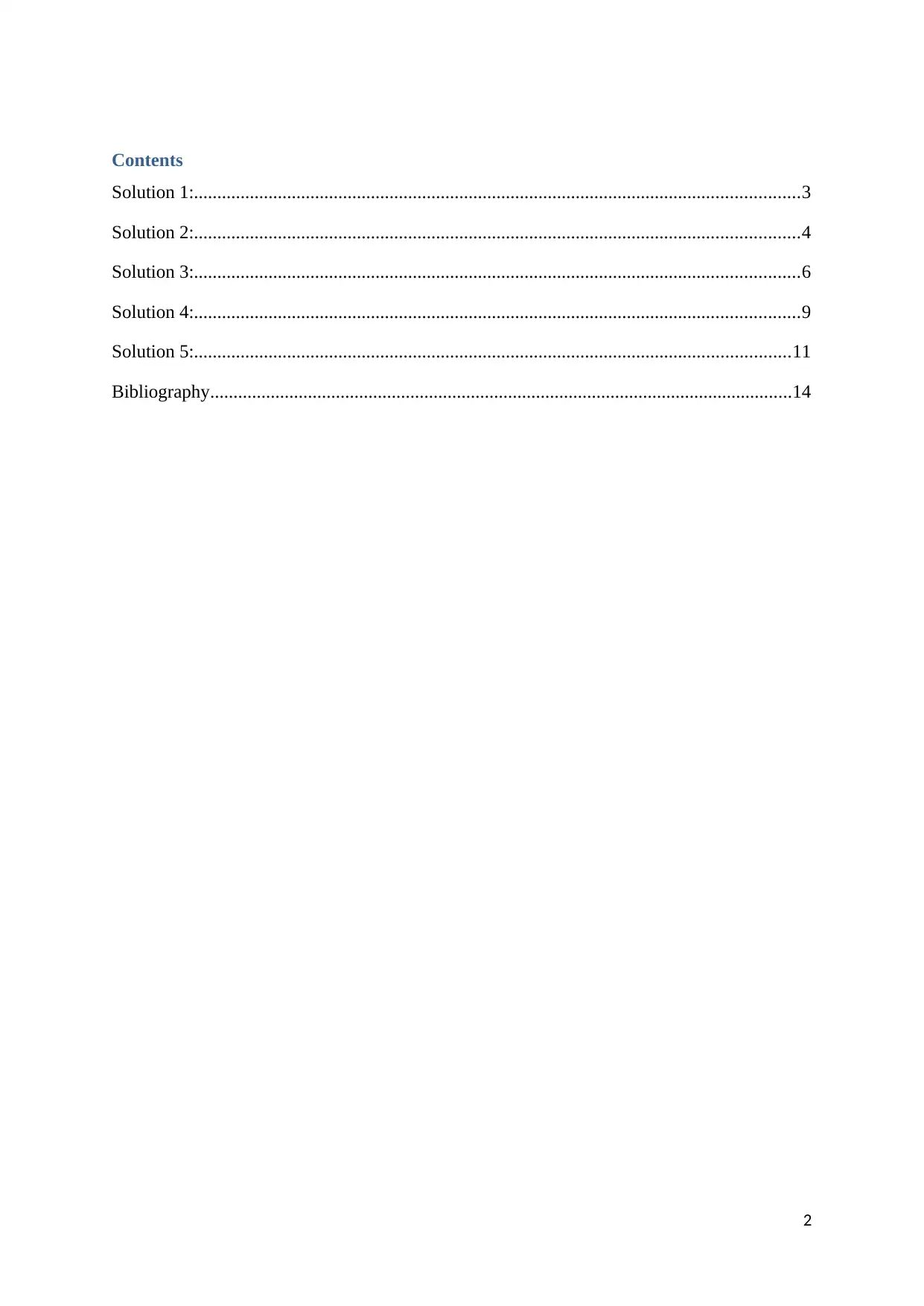
Contents
Solution 1:..................................................................................................................................3
Solution 2:..................................................................................................................................4
Solution 3:..................................................................................................................................6
Solution 4:..................................................................................................................................9
Solution 5:................................................................................................................................11
Bibliography.............................................................................................................................14
2
Solution 1:..................................................................................................................................3
Solution 2:..................................................................................................................................4
Solution 3:..................................................................................................................................6
Solution 4:..................................................................................................................................9
Solution 5:................................................................................................................................11
Bibliography.............................................................................................................................14
2
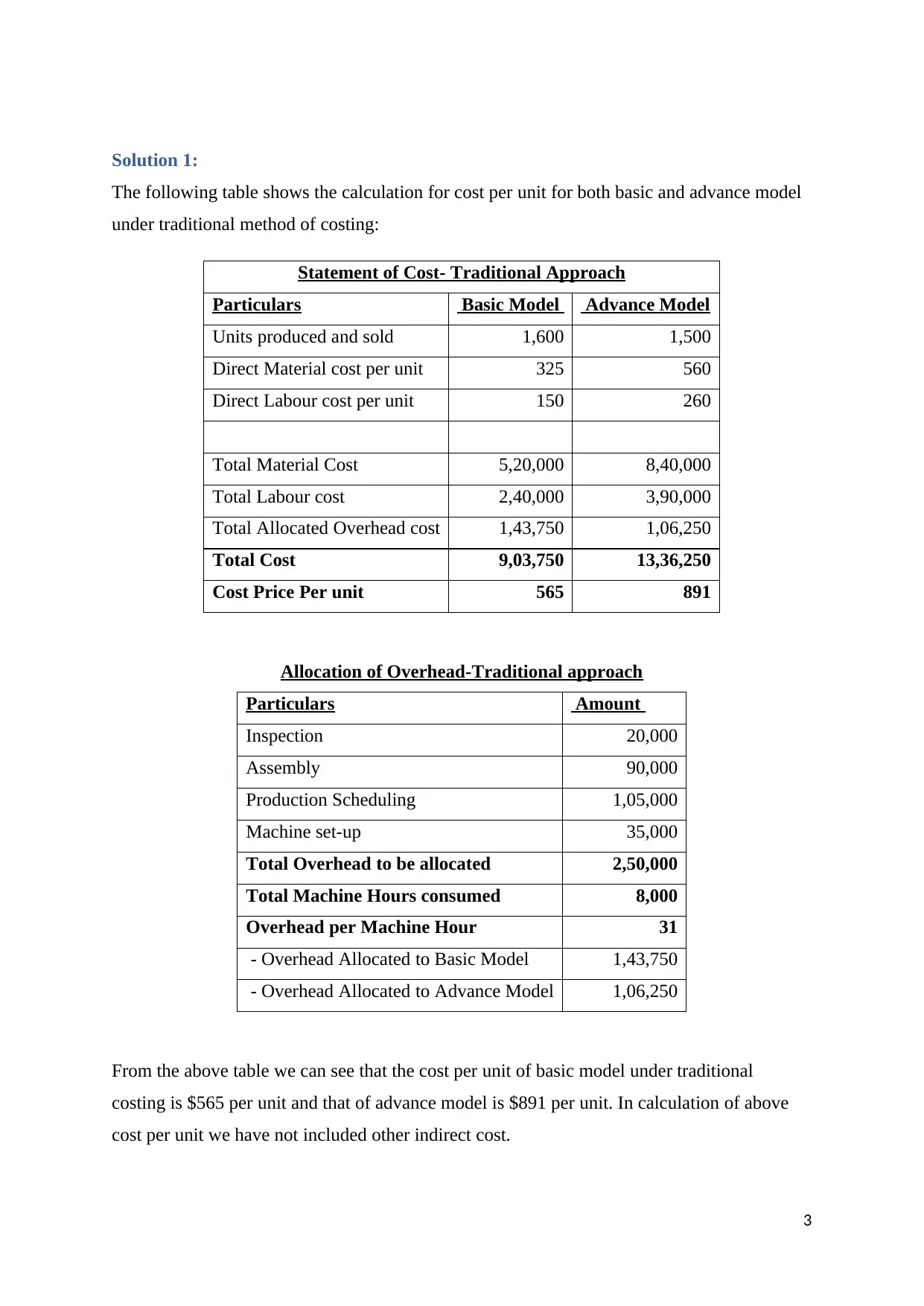
Solution 1:
The following table shows the calculation for cost per unit for both basic and advance model
under traditional method of costing:
Statement of Cost- Traditional Approach
Particulars Basic Model Advance Model
Units produced and sold 1,600 1,500
Direct Material cost per unit 325 560
Direct Labour cost per unit 150 260
Total Material Cost 5,20,000 8,40,000
Total Labour cost 2,40,000 3,90,000
Total Allocated Overhead cost 1,43,750 1,06,250
Total Cost 9,03,750 13,36,250
Cost Price Per unit 565 891
Allocation of Overhead-Traditional approach
Particulars Amount
Inspection 20,000
Assembly 90,000
Production Scheduling 1,05,000
Machine set-up 35,000
Total Overhead to be allocated 2,50,000
Total Machine Hours consumed 8,000
Overhead per Machine Hour 31
- Overhead Allocated to Basic Model 1,43,750
- Overhead Allocated to Advance Model 1,06,250
From the above table we can see that the cost per unit of basic model under traditional
costing is $565 per unit and that of advance model is $891 per unit. In calculation of above
cost per unit we have not included other indirect cost.
3
The following table shows the calculation for cost per unit for both basic and advance model
under traditional method of costing:
Statement of Cost- Traditional Approach
Particulars Basic Model Advance Model
Units produced and sold 1,600 1,500
Direct Material cost per unit 325 560
Direct Labour cost per unit 150 260
Total Material Cost 5,20,000 8,40,000
Total Labour cost 2,40,000 3,90,000
Total Allocated Overhead cost 1,43,750 1,06,250
Total Cost 9,03,750 13,36,250
Cost Price Per unit 565 891
Allocation of Overhead-Traditional approach
Particulars Amount
Inspection 20,000
Assembly 90,000
Production Scheduling 1,05,000
Machine set-up 35,000
Total Overhead to be allocated 2,50,000
Total Machine Hours consumed 8,000
Overhead per Machine Hour 31
- Overhead Allocated to Basic Model 1,43,750
- Overhead Allocated to Advance Model 1,06,250
From the above table we can see that the cost per unit of basic model under traditional
costing is $565 per unit and that of advance model is $891 per unit. In calculation of above
cost per unit we have not included other indirect cost.
3
You're viewing a preview
Unlock full access by subscribing today!
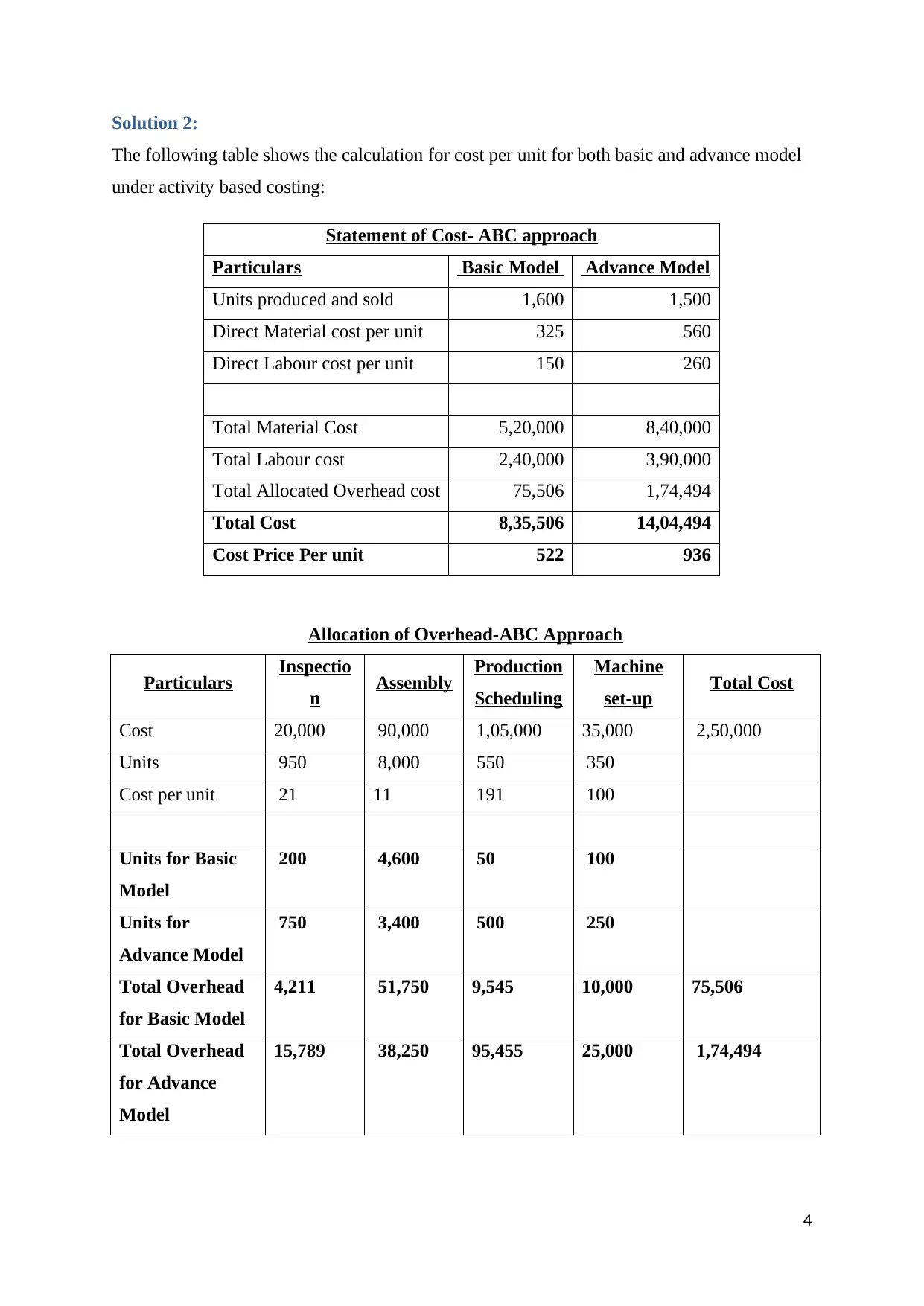
Solution 2:
The following table shows the calculation for cost per unit for both basic and advance model
under activity based costing:
Statement of Cost- ABC approach
Particulars Basic Model Advance Model
Units produced and sold 1,600 1,500
Direct Material cost per unit 325 560
Direct Labour cost per unit 150 260
Total Material Cost 5,20,000 8,40,000
Total Labour cost 2,40,000 3,90,000
Total Allocated Overhead cost 75,506 1,74,494
Total Cost 8,35,506 14,04,494
Cost Price Per unit 522 936
Allocation of Overhead-ABC Approach
Particulars Inspectio
n Assembly Production
Scheduling
Machine
set-up Total Cost
Cost 20,000 90,000 1,05,000 35,000 2,50,000
Units 950 8,000 550 350
Cost per unit 21 11 191 100
Units for Basic
Model
200 4,600 50 100
Units for
Advance Model
750 3,400 500 250
Total Overhead
for Basic Model
4,211 51,750 9,545 10,000 75,506
Total Overhead
for Advance
Model
15,789 38,250 95,455 25,000 1,74,494
4
The following table shows the calculation for cost per unit for both basic and advance model
under activity based costing:
Statement of Cost- ABC approach
Particulars Basic Model Advance Model
Units produced and sold 1,600 1,500
Direct Material cost per unit 325 560
Direct Labour cost per unit 150 260
Total Material Cost 5,20,000 8,40,000
Total Labour cost 2,40,000 3,90,000
Total Allocated Overhead cost 75,506 1,74,494
Total Cost 8,35,506 14,04,494
Cost Price Per unit 522 936
Allocation of Overhead-ABC Approach
Particulars Inspectio
n Assembly Production
Scheduling
Machine
set-up Total Cost
Cost 20,000 90,000 1,05,000 35,000 2,50,000
Units 950 8,000 550 350
Cost per unit 21 11 191 100
Units for Basic
Model
200 4,600 50 100
Units for
Advance Model
750 3,400 500 250
Total Overhead
for Basic Model
4,211 51,750 9,545 10,000 75,506
Total Overhead
for Advance
Model
15,789 38,250 95,455 25,000 1,74,494
4
Paraphrase This Document
Need a fresh take? Get an instant paraphrase of this document with our AI Paraphraser
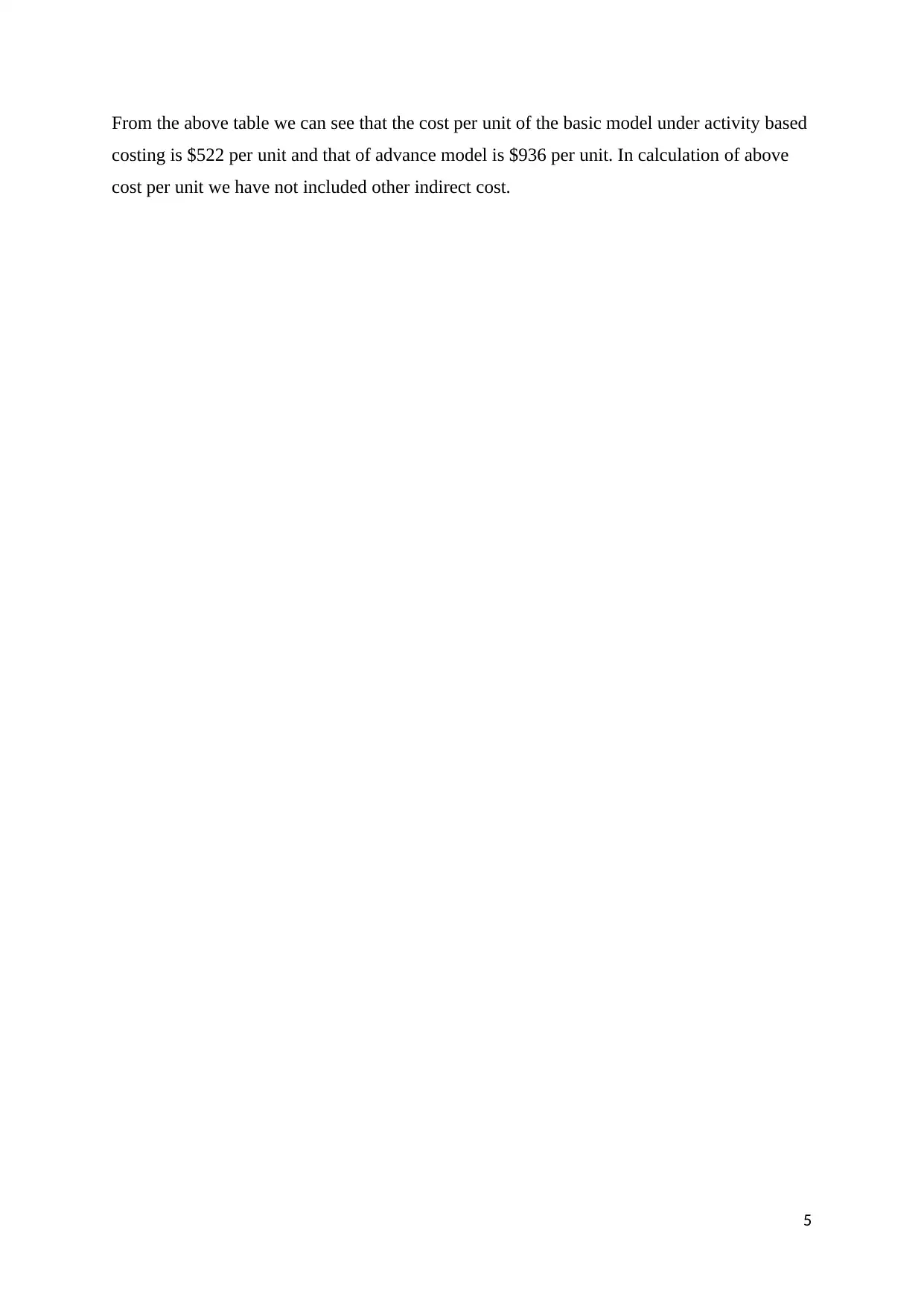
From the above table we can see that the cost per unit of the basic model under activity based
costing is $522 per unit and that of advance model is $936 per unit. In calculation of above
cost per unit we have not included other indirect cost.
5
costing is $522 per unit and that of advance model is $936 per unit. In calculation of above
cost per unit we have not included other indirect cost.
5
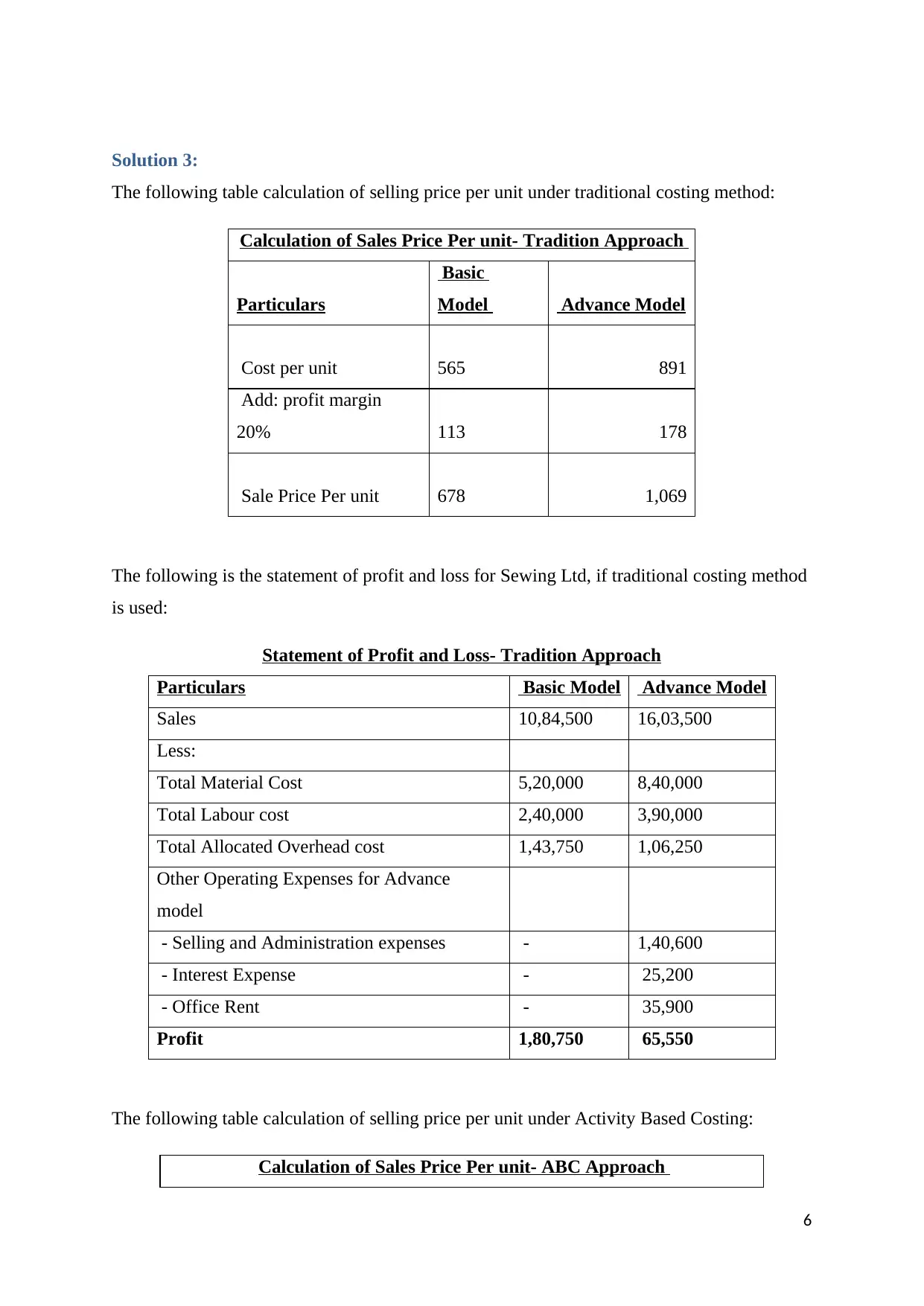
Solution 3:
The following table calculation of selling price per unit under traditional costing method:
Calculation of Sales Price Per unit- Tradition Approach
Particulars
Basic
Model Advance Model
Cost per unit 565 891
Add: profit margin
20% 113 178
Sale Price Per unit 678 1,069
The following is the statement of profit and loss for Sewing Ltd, if traditional costing method
is used:
Statement of Profit and Loss- Tradition Approach
Particulars Basic Model Advance Model
Sales 10,84,500 16,03,500
Less:
Total Material Cost 5,20,000 8,40,000
Total Labour cost 2,40,000 3,90,000
Total Allocated Overhead cost 1,43,750 1,06,250
Other Operating Expenses for Advance
model
- Selling and Administration expenses - 1,40,600
- Interest Expense - 25,200
- Office Rent - 35,900
Profit 1,80,750 65,550
The following table calculation of selling price per unit under Activity Based Costing:
Calculation of Sales Price Per unit- ABC Approach
6
The following table calculation of selling price per unit under traditional costing method:
Calculation of Sales Price Per unit- Tradition Approach
Particulars
Basic
Model Advance Model
Cost per unit 565 891
Add: profit margin
20% 113 178
Sale Price Per unit 678 1,069
The following is the statement of profit and loss for Sewing Ltd, if traditional costing method
is used:
Statement of Profit and Loss- Tradition Approach
Particulars Basic Model Advance Model
Sales 10,84,500 16,03,500
Less:
Total Material Cost 5,20,000 8,40,000
Total Labour cost 2,40,000 3,90,000
Total Allocated Overhead cost 1,43,750 1,06,250
Other Operating Expenses for Advance
model
- Selling and Administration expenses - 1,40,600
- Interest Expense - 25,200
- Office Rent - 35,900
Profit 1,80,750 65,550
The following table calculation of selling price per unit under Activity Based Costing:
Calculation of Sales Price Per unit- ABC Approach
6
You're viewing a preview
Unlock full access by subscribing today!
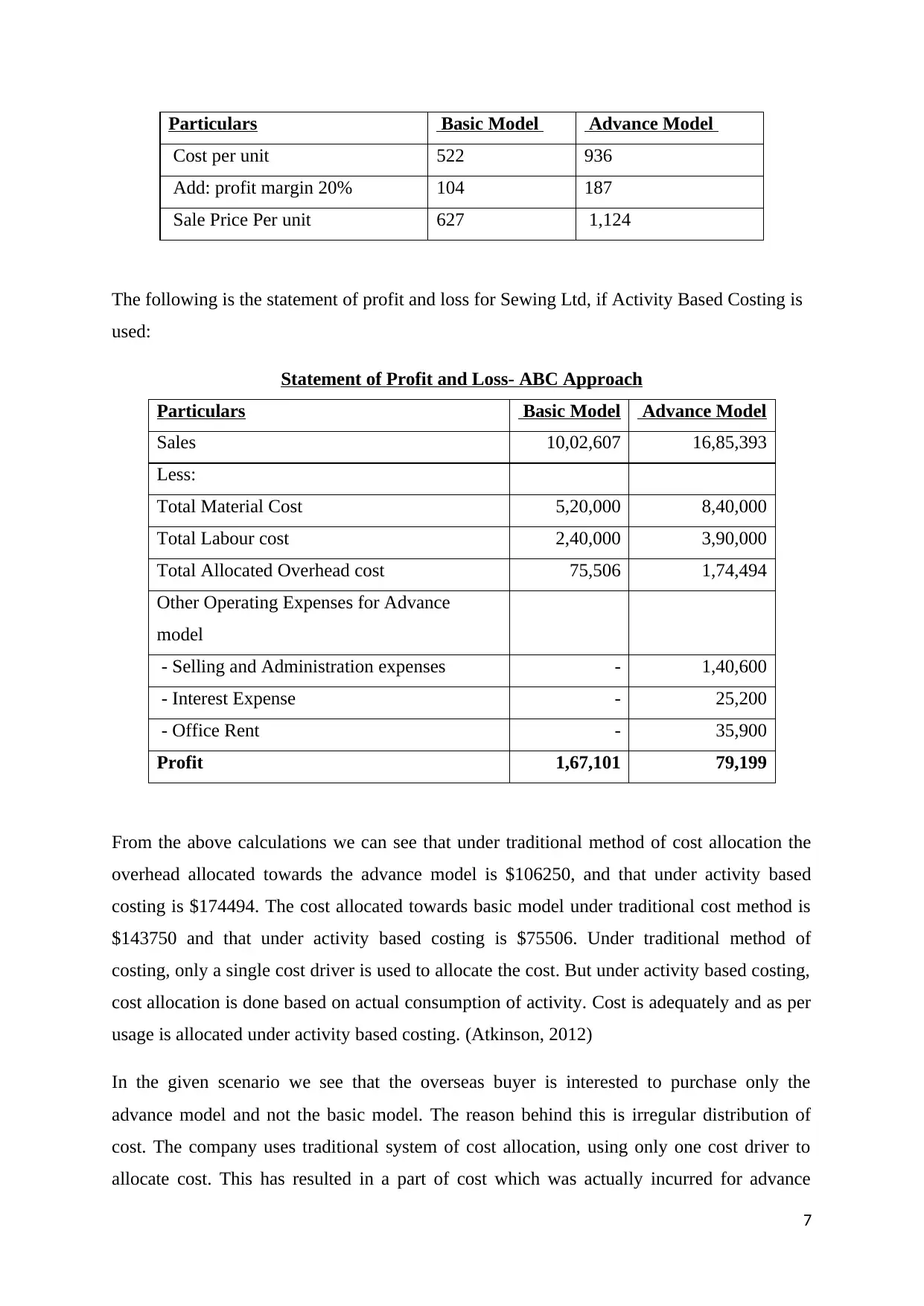
Particulars Basic Model Advance Model
Cost per unit 522 936
Add: profit margin 20% 104 187
Sale Price Per unit 627 1,124
The following is the statement of profit and loss for Sewing Ltd, if Activity Based Costing is
used:
Statement of Profit and Loss- ABC Approach
Particulars Basic Model Advance Model
Sales 10,02,607 16,85,393
Less:
Total Material Cost 5,20,000 8,40,000
Total Labour cost 2,40,000 3,90,000
Total Allocated Overhead cost 75,506 1,74,494
Other Operating Expenses for Advance
model
- Selling and Administration expenses - 1,40,600
- Interest Expense - 25,200
- Office Rent - 35,900
Profit 1,67,101 79,199
From the above calculations we can see that under traditional method of cost allocation the
overhead allocated towards the advance model is $106250, and that under activity based
costing is $174494. The cost allocated towards basic model under traditional cost method is
$143750 and that under activity based costing is $75506. Under traditional method of
costing, only a single cost driver is used to allocate the cost. But under activity based costing,
cost allocation is done based on actual consumption of activity. Cost is adequately and as per
usage is allocated under activity based costing. (Atkinson, 2012)
In the given scenario we see that the overseas buyer is interested to purchase only the
advance model and not the basic model. The reason behind this is irregular distribution of
cost. The company uses traditional system of cost allocation, using only one cost driver to
allocate cost. This has resulted in a part of cost which was actually incurred for advance
7
Cost per unit 522 936
Add: profit margin 20% 104 187
Sale Price Per unit 627 1,124
The following is the statement of profit and loss for Sewing Ltd, if Activity Based Costing is
used:
Statement of Profit and Loss- ABC Approach
Particulars Basic Model Advance Model
Sales 10,02,607 16,85,393
Less:
Total Material Cost 5,20,000 8,40,000
Total Labour cost 2,40,000 3,90,000
Total Allocated Overhead cost 75,506 1,74,494
Other Operating Expenses for Advance
model
- Selling and Administration expenses - 1,40,600
- Interest Expense - 25,200
- Office Rent - 35,900
Profit 1,67,101 79,199
From the above calculations we can see that under traditional method of cost allocation the
overhead allocated towards the advance model is $106250, and that under activity based
costing is $174494. The cost allocated towards basic model under traditional cost method is
$143750 and that under activity based costing is $75506. Under traditional method of
costing, only a single cost driver is used to allocate the cost. But under activity based costing,
cost allocation is done based on actual consumption of activity. Cost is adequately and as per
usage is allocated under activity based costing. (Atkinson, 2012)
In the given scenario we see that the overseas buyer is interested to purchase only the
advance model and not the basic model. The reason behind this is irregular distribution of
cost. The company uses traditional system of cost allocation, using only one cost driver to
allocate cost. This has resulted in a part of cost which was actually incurred for advance
7
Paraphrase This Document
Need a fresh take? Get an instant paraphrase of this document with our AI Paraphraser

model to be shifted to basic model. Since, the cost allocated is less towards the advance
model; the selling price for the same is also reduced. The company is currently charging $
1069 per unit for advance model from the overseas buyer. If the company would have used
activity based costing the, price charged from the customer would have been $1124. The
overseas buyer has observed this difference in price for $55 per unit. Since sewing ltd is
charging $55 less per unit on the advance model, the overseas buyer is interested in buying
only the advance model.
For basic model, the company is charging $678 per unit under traditional costing method. If it
uses activity based costing then the company would charge $627 per unit for the basic model.
Since the company is using traditional costing method, it is charging $51 per unit more on the
basic model. The overseas buyer can purchase the basic model from market at $627 per unit.
This is why the overseas buyer is not interested in buying the basic model form Sewing Ltd.
Therefore, we see that method of cost allocation has a high effect on the product pricing.
Using the correct method of cost allocation is very important, as it affects the buyer’s
decision. (Berry, 2009) Wrong allocation of cost among products may lead to financial
troubles for the company.
8
model; the selling price for the same is also reduced. The company is currently charging $
1069 per unit for advance model from the overseas buyer. If the company would have used
activity based costing the, price charged from the customer would have been $1124. The
overseas buyer has observed this difference in price for $55 per unit. Since sewing ltd is
charging $55 less per unit on the advance model, the overseas buyer is interested in buying
only the advance model.
For basic model, the company is charging $678 per unit under traditional costing method. If it
uses activity based costing then the company would charge $627 per unit for the basic model.
Since the company is using traditional costing method, it is charging $51 per unit more on the
basic model. The overseas buyer can purchase the basic model from market at $627 per unit.
This is why the overseas buyer is not interested in buying the basic model form Sewing Ltd.
Therefore, we see that method of cost allocation has a high effect on the product pricing.
Using the correct method of cost allocation is very important, as it affects the buyer’s
decision. (Berry, 2009) Wrong allocation of cost among products may lead to financial
troubles for the company.
8
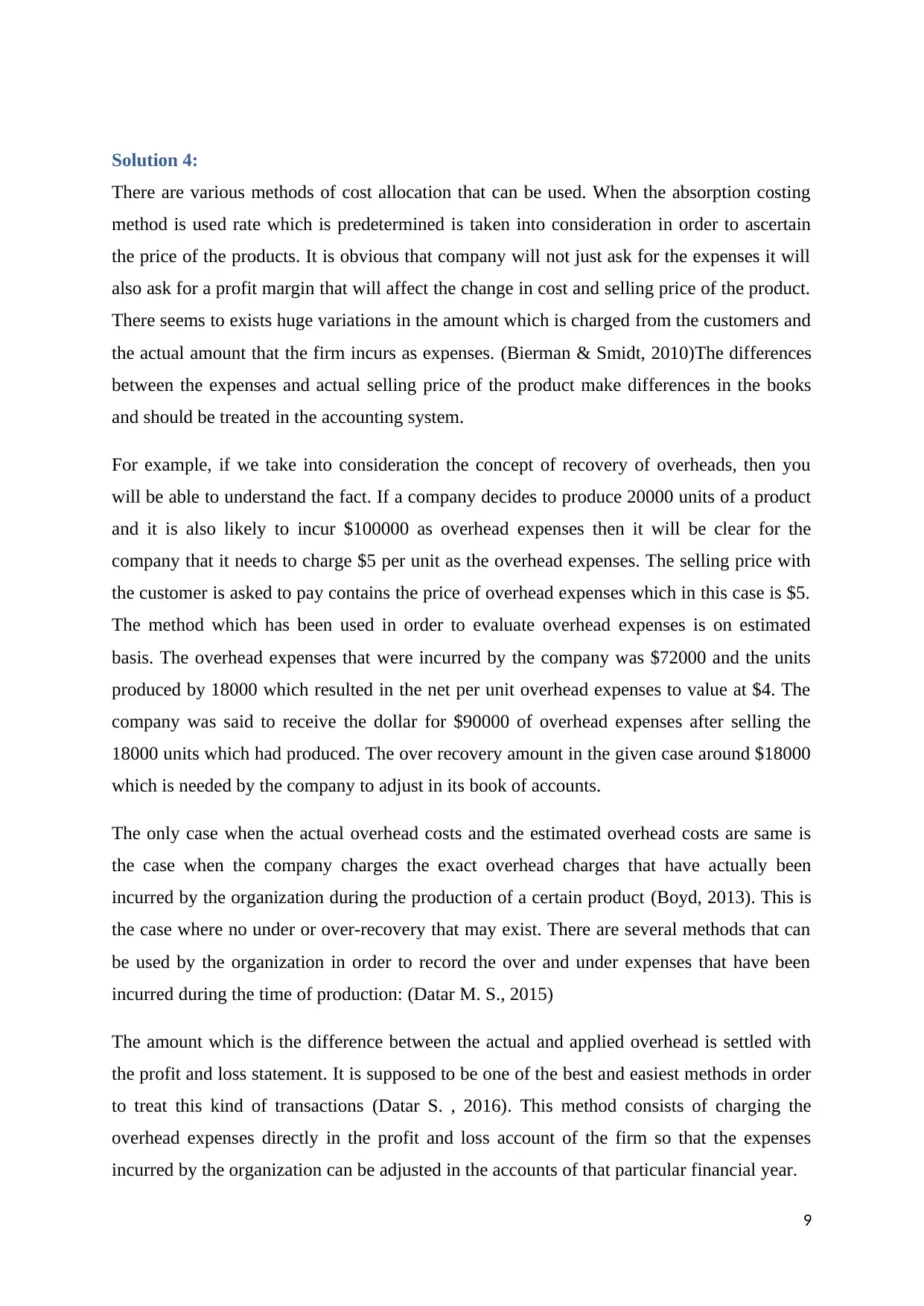
Solution 4:
There are various methods of cost allocation that can be used. When the absorption costing
method is used rate which is predetermined is taken into consideration in order to ascertain
the price of the products. It is obvious that company will not just ask for the expenses it will
also ask for a profit margin that will affect the change in cost and selling price of the product.
There seems to exists huge variations in the amount which is charged from the customers and
the actual amount that the firm incurs as expenses. (Bierman & Smidt, 2010)The differences
between the expenses and actual selling price of the product make differences in the books
and should be treated in the accounting system.
For example, if we take into consideration the concept of recovery of overheads, then you
will be able to understand the fact. If a company decides to produce 20000 units of a product
and it is also likely to incur $100000 as overhead expenses then it will be clear for the
company that it needs to charge $5 per unit as the overhead expenses. The selling price with
the customer is asked to pay contains the price of overhead expenses which in this case is $5.
The method which has been used in order to evaluate overhead expenses is on estimated
basis. The overhead expenses that were incurred by the company was $72000 and the units
produced by 18000 which resulted in the net per unit overhead expenses to value at $4. The
company was said to receive the dollar for $90000 of overhead expenses after selling the
18000 units which had produced. The over recovery amount in the given case around $18000
which is needed by the company to adjust in its book of accounts.
The only case when the actual overhead costs and the estimated overhead costs are same is
the case when the company charges the exact overhead charges that have actually been
incurred by the organization during the production of a certain product (Boyd, 2013). This is
the case where no under or over-recovery that may exist. There are several methods that can
be used by the organization in order to record the over and under expenses that have been
incurred during the time of production: (Datar M. S., 2015)
The amount which is the difference between the actual and applied overhead is settled with
the profit and loss statement. It is supposed to be one of the best and easiest methods in order
to treat this kind of transactions (Datar S. , 2016). This method consists of charging the
overhead expenses directly in the profit and loss account of the firm so that the expenses
incurred by the organization can be adjusted in the accounts of that particular financial year.
9
There are various methods of cost allocation that can be used. When the absorption costing
method is used rate which is predetermined is taken into consideration in order to ascertain
the price of the products. It is obvious that company will not just ask for the expenses it will
also ask for a profit margin that will affect the change in cost and selling price of the product.
There seems to exists huge variations in the amount which is charged from the customers and
the actual amount that the firm incurs as expenses. (Bierman & Smidt, 2010)The differences
between the expenses and actual selling price of the product make differences in the books
and should be treated in the accounting system.
For example, if we take into consideration the concept of recovery of overheads, then you
will be able to understand the fact. If a company decides to produce 20000 units of a product
and it is also likely to incur $100000 as overhead expenses then it will be clear for the
company that it needs to charge $5 per unit as the overhead expenses. The selling price with
the customer is asked to pay contains the price of overhead expenses which in this case is $5.
The method which has been used in order to evaluate overhead expenses is on estimated
basis. The overhead expenses that were incurred by the company was $72000 and the units
produced by 18000 which resulted in the net per unit overhead expenses to value at $4. The
company was said to receive the dollar for $90000 of overhead expenses after selling the
18000 units which had produced. The over recovery amount in the given case around $18000
which is needed by the company to adjust in its book of accounts.
The only case when the actual overhead costs and the estimated overhead costs are same is
the case when the company charges the exact overhead charges that have actually been
incurred by the organization during the production of a certain product (Boyd, 2013). This is
the case where no under or over-recovery that may exist. There are several methods that can
be used by the organization in order to record the over and under expenses that have been
incurred during the time of production: (Datar M. S., 2015)
The amount which is the difference between the actual and applied overhead is settled with
the profit and loss statement. It is supposed to be one of the best and easiest methods in order
to treat this kind of transactions (Datar S. , 2016). This method consists of charging the
overhead expenses directly in the profit and loss account of the firm so that the expenses
incurred by the organization can be adjusted in the accounts of that particular financial year.
9
You're viewing a preview
Unlock full access by subscribing today!
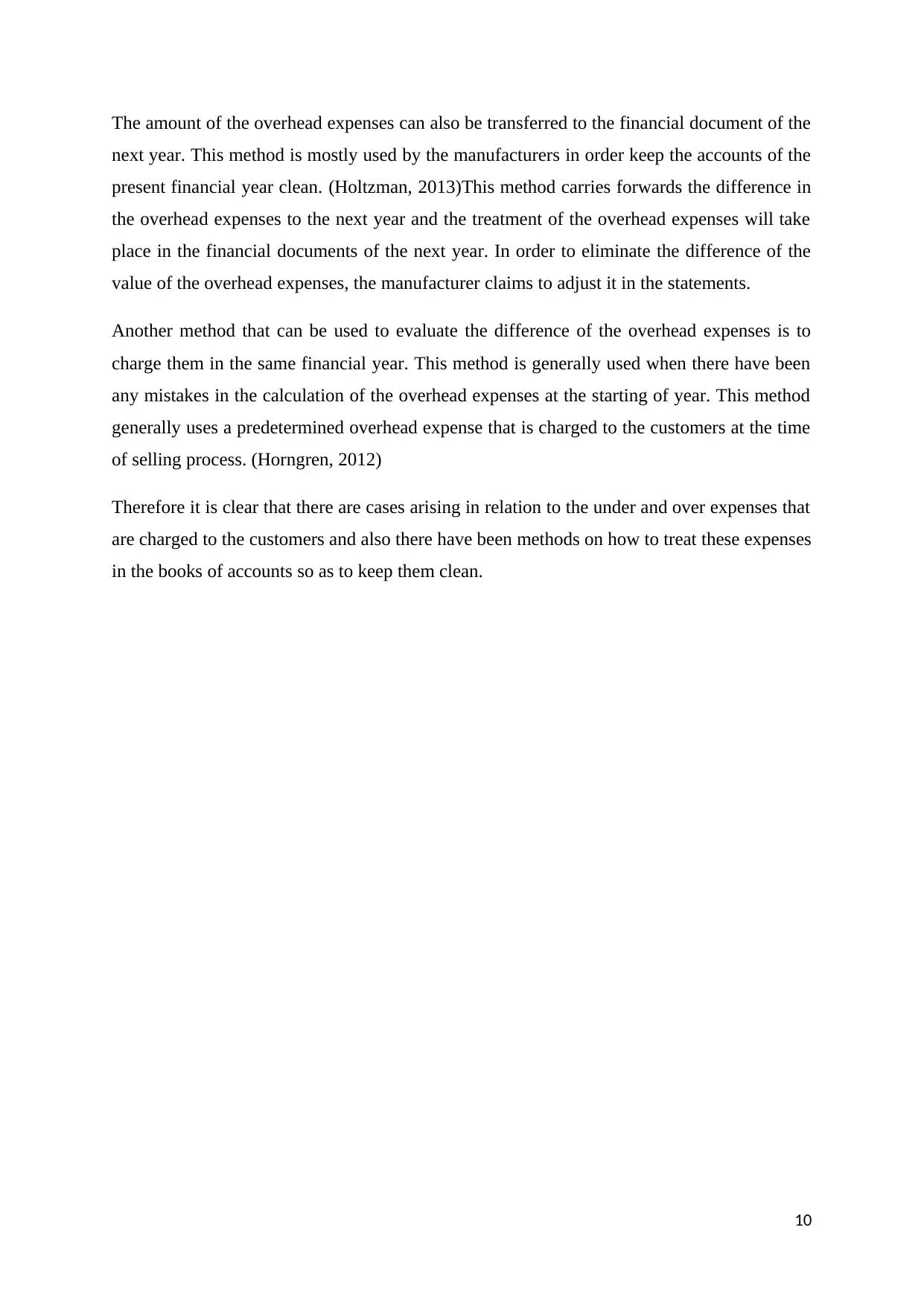
The amount of the overhead expenses can also be transferred to the financial document of the
next year. This method is mostly used by the manufacturers in order keep the accounts of the
present financial year clean. (Holtzman, 2013)This method carries forwards the difference in
the overhead expenses to the next year and the treatment of the overhead expenses will take
place in the financial documents of the next year. In order to eliminate the difference of the
value of the overhead expenses, the manufacturer claims to adjust it in the statements.
Another method that can be used to evaluate the difference of the overhead expenses is to
charge them in the same financial year. This method is generally used when there have been
any mistakes in the calculation of the overhead expenses at the starting of year. This method
generally uses a predetermined overhead expense that is charged to the customers at the time
of selling process. (Horngren, 2012)
Therefore it is clear that there are cases arising in relation to the under and over expenses that
are charged to the customers and also there have been methods on how to treat these expenses
in the books of accounts so as to keep them clean.
10
next year. This method is mostly used by the manufacturers in order keep the accounts of the
present financial year clean. (Holtzman, 2013)This method carries forwards the difference in
the overhead expenses to the next year and the treatment of the overhead expenses will take
place in the financial documents of the next year. In order to eliminate the difference of the
value of the overhead expenses, the manufacturer claims to adjust it in the statements.
Another method that can be used to evaluate the difference of the overhead expenses is to
charge them in the same financial year. This method is generally used when there have been
any mistakes in the calculation of the overhead expenses at the starting of year. This method
generally uses a predetermined overhead expense that is charged to the customers at the time
of selling process. (Horngren, 2012)
Therefore it is clear that there are cases arising in relation to the under and over expenses that
are charged to the customers and also there have been methods on how to treat these expenses
in the books of accounts so as to keep them clean.
10
Paraphrase This Document
Need a fresh take? Get an instant paraphrase of this document with our AI Paraphraser
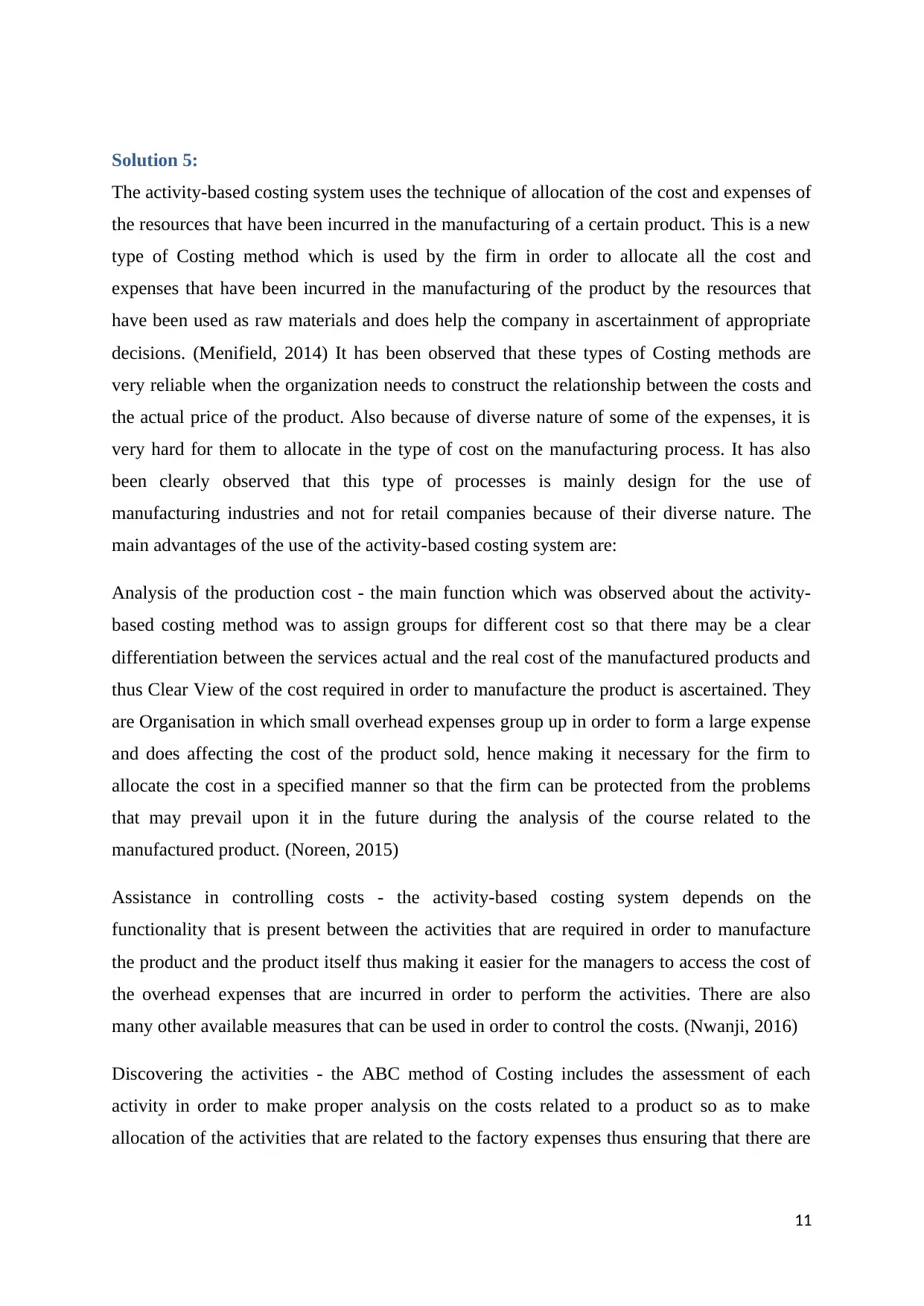
Solution 5:
The activity-based costing system uses the technique of allocation of the cost and expenses of
the resources that have been incurred in the manufacturing of a certain product. This is a new
type of Costing method which is used by the firm in order to allocate all the cost and
expenses that have been incurred in the manufacturing of the product by the resources that
have been used as raw materials and does help the company in ascertainment of appropriate
decisions. (Menifield, 2014) It has been observed that these types of Costing methods are
very reliable when the organization needs to construct the relationship between the costs and
the actual price of the product. Also because of diverse nature of some of the expenses, it is
very hard for them to allocate in the type of cost on the manufacturing process. It has also
been clearly observed that this type of processes is mainly design for the use of
manufacturing industries and not for retail companies because of their diverse nature. The
main advantages of the use of the activity-based costing system are:
Analysis of the production cost - the main function which was observed about the activity-
based costing method was to assign groups for different cost so that there may be a clear
differentiation between the services actual and the real cost of the manufactured products and
thus Clear View of the cost required in order to manufacture the product is ascertained. They
are Organisation in which small overhead expenses group up in order to form a large expense
and does affecting the cost of the product sold, hence making it necessary for the firm to
allocate the cost in a specified manner so that the firm can be protected from the problems
that may prevail upon it in the future during the analysis of the course related to the
manufactured product. (Noreen, 2015)
Assistance in controlling costs - the activity-based costing system depends on the
functionality that is present between the activities that are required in order to manufacture
the product and the product itself thus making it easier for the managers to access the cost of
the overhead expenses that are incurred in order to perform the activities. There are also
many other available measures that can be used in order to control the costs. (Nwanji, 2016)
Discovering the activities - the ABC method of Costing includes the assessment of each
activity in order to make proper analysis on the costs related to a product so as to make
allocation of the activities that are related to the factory expenses thus ensuring that there are
11
The activity-based costing system uses the technique of allocation of the cost and expenses of
the resources that have been incurred in the manufacturing of a certain product. This is a new
type of Costing method which is used by the firm in order to allocate all the cost and
expenses that have been incurred in the manufacturing of the product by the resources that
have been used as raw materials and does help the company in ascertainment of appropriate
decisions. (Menifield, 2014) It has been observed that these types of Costing methods are
very reliable when the organization needs to construct the relationship between the costs and
the actual price of the product. Also because of diverse nature of some of the expenses, it is
very hard for them to allocate in the type of cost on the manufacturing process. It has also
been clearly observed that this type of processes is mainly design for the use of
manufacturing industries and not for retail companies because of their diverse nature. The
main advantages of the use of the activity-based costing system are:
Analysis of the production cost - the main function which was observed about the activity-
based costing method was to assign groups for different cost so that there may be a clear
differentiation between the services actual and the real cost of the manufactured products and
thus Clear View of the cost required in order to manufacture the product is ascertained. They
are Organisation in which small overhead expenses group up in order to form a large expense
and does affecting the cost of the product sold, hence making it necessary for the firm to
allocate the cost in a specified manner so that the firm can be protected from the problems
that may prevail upon it in the future during the analysis of the course related to the
manufactured product. (Noreen, 2015)
Assistance in controlling costs - the activity-based costing system depends on the
functionality that is present between the activities that are required in order to manufacture
the product and the product itself thus making it easier for the managers to access the cost of
the overhead expenses that are incurred in order to perform the activities. There are also
many other available measures that can be used in order to control the costs. (Nwanji, 2016)
Discovering the activities - the ABC method of Costing includes the assessment of each
activity in order to make proper analysis on the costs related to a product so as to make
allocation of the activities that are related to the factory expenses thus ensuring that there are
11
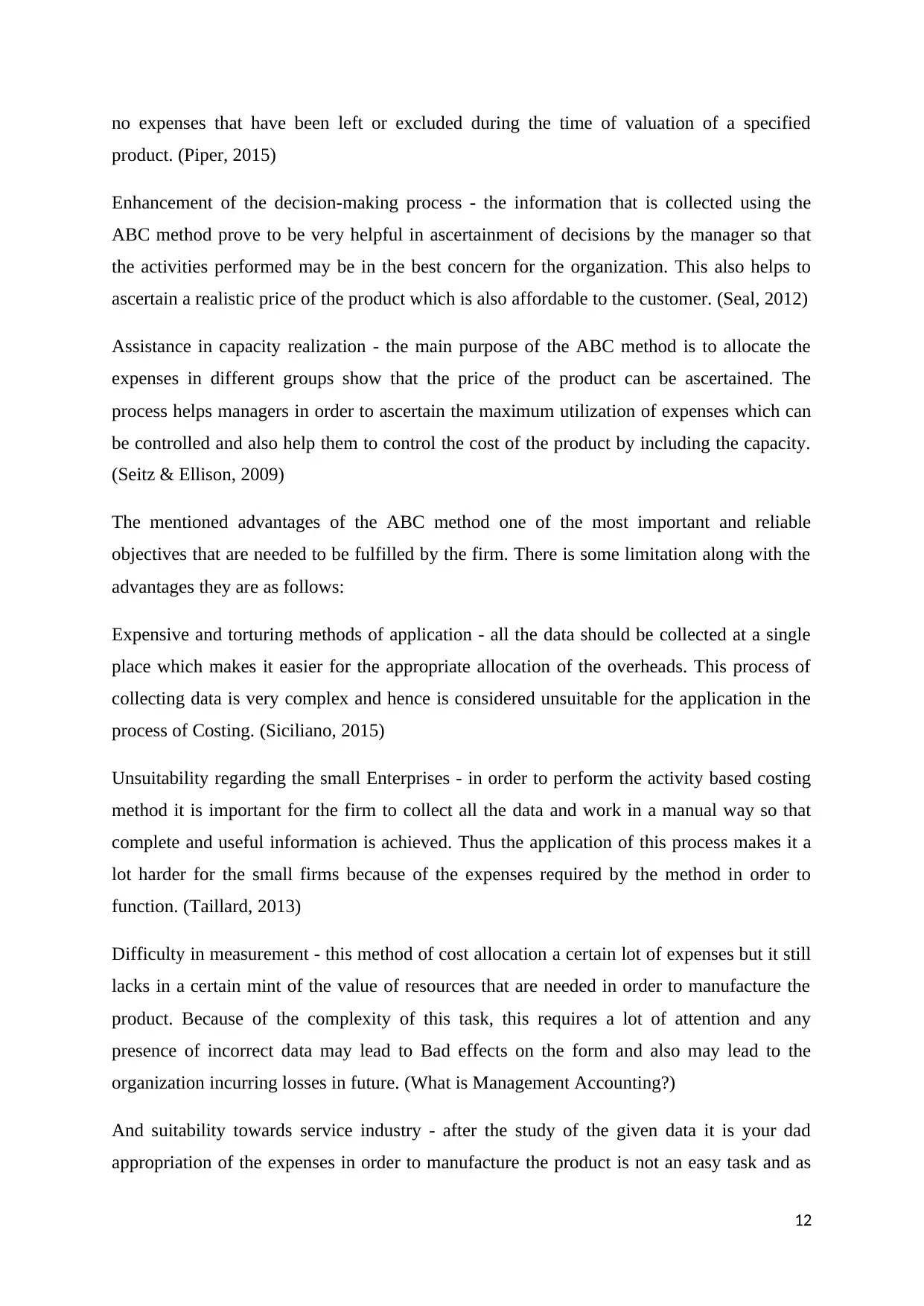
no expenses that have been left or excluded during the time of valuation of a specified
product. (Piper, 2015)
Enhancement of the decision-making process - the information that is collected using the
ABC method prove to be very helpful in ascertainment of decisions by the manager so that
the activities performed may be in the best concern for the organization. This also helps to
ascertain a realistic price of the product which is also affordable to the customer. (Seal, 2012)
Assistance in capacity realization - the main purpose of the ABC method is to allocate the
expenses in different groups show that the price of the product can be ascertained. The
process helps managers in order to ascertain the maximum utilization of expenses which can
be controlled and also help them to control the cost of the product by including the capacity.
(Seitz & Ellison, 2009)
The mentioned advantages of the ABC method one of the most important and reliable
objectives that are needed to be fulfilled by the firm. There is some limitation along with the
advantages they are as follows:
Expensive and torturing methods of application - all the data should be collected at a single
place which makes it easier for the appropriate allocation of the overheads. This process of
collecting data is very complex and hence is considered unsuitable for the application in the
process of Costing. (Siciliano, 2015)
Unsuitability regarding the small Enterprises - in order to perform the activity based costing
method it is important for the firm to collect all the data and work in a manual way so that
complete and useful information is achieved. Thus the application of this process makes it a
lot harder for the small firms because of the expenses required by the method in order to
function. (Taillard, 2013)
Difficulty in measurement - this method of cost allocation a certain lot of expenses but it still
lacks in a certain mint of the value of resources that are needed in order to manufacture the
product. Because of the complexity of this task, this requires a lot of attention and any
presence of incorrect data may lead to Bad effects on the form and also may lead to the
organization incurring losses in future. (What is Management Accounting?)
And suitability towards service industry - after the study of the given data it is your dad
appropriation of the expenses in order to manufacture the product is not an easy task and as
12
product. (Piper, 2015)
Enhancement of the decision-making process - the information that is collected using the
ABC method prove to be very helpful in ascertainment of decisions by the manager so that
the activities performed may be in the best concern for the organization. This also helps to
ascertain a realistic price of the product which is also affordable to the customer. (Seal, 2012)
Assistance in capacity realization - the main purpose of the ABC method is to allocate the
expenses in different groups show that the price of the product can be ascertained. The
process helps managers in order to ascertain the maximum utilization of expenses which can
be controlled and also help them to control the cost of the product by including the capacity.
(Seitz & Ellison, 2009)
The mentioned advantages of the ABC method one of the most important and reliable
objectives that are needed to be fulfilled by the firm. There is some limitation along with the
advantages they are as follows:
Expensive and torturing methods of application - all the data should be collected at a single
place which makes it easier for the appropriate allocation of the overheads. This process of
collecting data is very complex and hence is considered unsuitable for the application in the
process of Costing. (Siciliano, 2015)
Unsuitability regarding the small Enterprises - in order to perform the activity based costing
method it is important for the firm to collect all the data and work in a manual way so that
complete and useful information is achieved. Thus the application of this process makes it a
lot harder for the small firms because of the expenses required by the method in order to
function. (Taillard, 2013)
Difficulty in measurement - this method of cost allocation a certain lot of expenses but it still
lacks in a certain mint of the value of resources that are needed in order to manufacture the
product. Because of the complexity of this task, this requires a lot of attention and any
presence of incorrect data may lead to Bad effects on the form and also may lead to the
organization incurring losses in future. (What is Management Accounting?)
And suitability towards service industry - after the study of the given data it is your dad
appropriation of the expenses in order to manufacture the product is not an easy task and as
12
You're viewing a preview
Unlock full access by subscribing today!

the service industry doesn't have any type of divisions of cost and utilities, the ascertainment
of the costs and their allocation is made difficult. (White, 2009)
Therefore after the clear analysis of the ABC method of costing we have come to the
conclusion that it is very helpful in the allocation of the cost but also have certain drawbacks.
Therefore it should be made necessary for the companies in order to analyze the
environmental changes before ascertaining any of the costing techniques.
13
of the costs and their allocation is made difficult. (White, 2009)
Therefore after the clear analysis of the ABC method of costing we have come to the
conclusion that it is very helpful in the allocation of the cost but also have certain drawbacks.
Therefore it should be made necessary for the companies in order to analyze the
environmental changes before ascertaining any of the costing techniques.
13
Paraphrase This Document
Need a fresh take? Get an instant paraphrase of this document with our AI Paraphraser

Bibliography
Atkinson, A. A. (2012). Management accounting. Upper Saddle River, N.J.: Paerson.
Berry, L. E. (2009). Management accounting demystified. New York: McGraw-Hill.
Bierman, H., & Smidt, S. (2010). The Capital Budgeting Decision. Boston: Routledge.
Boyd, W. K. (2013). Cost Accounting For Dummies. Hoboken: Wiley.
Datar, M. S. (2015). Cost accounting. Boston: Pearson.
Datar, S. (2016). Horngren's Cost Accounting: A Managerial Emphasis. Hoboken: Wiley.
Holtzman, M. (2013). Managerial Accounting For Dummies. Hoboken, NJ: Wiley.
Horngren, C. (2012). Cost accounting. Upper Saddle River, N.J.: Pearson/Prentice Hall.
Menifield, C. E. (2014). The Basics of Public Budgeting and Financial Management: A
Handbook for Academics and Practitioners. Lanham, Md.: University Press of America.
Noreen, E. (2015). The theory of constraints and its implications for management accounting.
Great Barrington, MA: North River Press.
Nwanji, T. (2016). Retrieved from http://www.managementjournals.com:
http://www.managementjournals.com/journals/ig/vol1/21-1-1-1.pdf
Piper, M. (2015). Accounting made simple. United States: CreateSpace Pub.
Seal, W. (2012). Management accounting. Maidenhead: McGraw-Hill Higher Education.
Seitz, N., & Ellison, M. (2009). Capital Budgeting and Long-Term Financing Decisions.
New York: Thomson Learning.
Siciliano, G. (2015). Finance for Nonfinancial Managers. New York: McGraw-Hill.
Taillard, M. (2013). Corporate finance for dummies. Hoboken, N.J.: Wiley.
What is Management Accounting? (n.d.). Retrieved from www.cimaglobal.com:
https://www.cimaglobal.com/Starting-CIMA/Why-CIMA/what-is-management-accounting/
14
Atkinson, A. A. (2012). Management accounting. Upper Saddle River, N.J.: Paerson.
Berry, L. E. (2009). Management accounting demystified. New York: McGraw-Hill.
Bierman, H., & Smidt, S. (2010). The Capital Budgeting Decision. Boston: Routledge.
Boyd, W. K. (2013). Cost Accounting For Dummies. Hoboken: Wiley.
Datar, M. S. (2015). Cost accounting. Boston: Pearson.
Datar, S. (2016). Horngren's Cost Accounting: A Managerial Emphasis. Hoboken: Wiley.
Holtzman, M. (2013). Managerial Accounting For Dummies. Hoboken, NJ: Wiley.
Horngren, C. (2012). Cost accounting. Upper Saddle River, N.J.: Pearson/Prentice Hall.
Menifield, C. E. (2014). The Basics of Public Budgeting and Financial Management: A
Handbook for Academics and Practitioners. Lanham, Md.: University Press of America.
Noreen, E. (2015). The theory of constraints and its implications for management accounting.
Great Barrington, MA: North River Press.
Nwanji, T. (2016). Retrieved from http://www.managementjournals.com:
http://www.managementjournals.com/journals/ig/vol1/21-1-1-1.pdf
Piper, M. (2015). Accounting made simple. United States: CreateSpace Pub.
Seal, W. (2012). Management accounting. Maidenhead: McGraw-Hill Higher Education.
Seitz, N., & Ellison, M. (2009). Capital Budgeting and Long-Term Financing Decisions.
New York: Thomson Learning.
Siciliano, G. (2015). Finance for Nonfinancial Managers. New York: McGraw-Hill.
Taillard, M. (2013). Corporate finance for dummies. Hoboken, N.J.: Wiley.
What is Management Accounting? (n.d.). Retrieved from www.cimaglobal.com:
https://www.cimaglobal.com/Starting-CIMA/Why-CIMA/what-is-management-accounting/
14
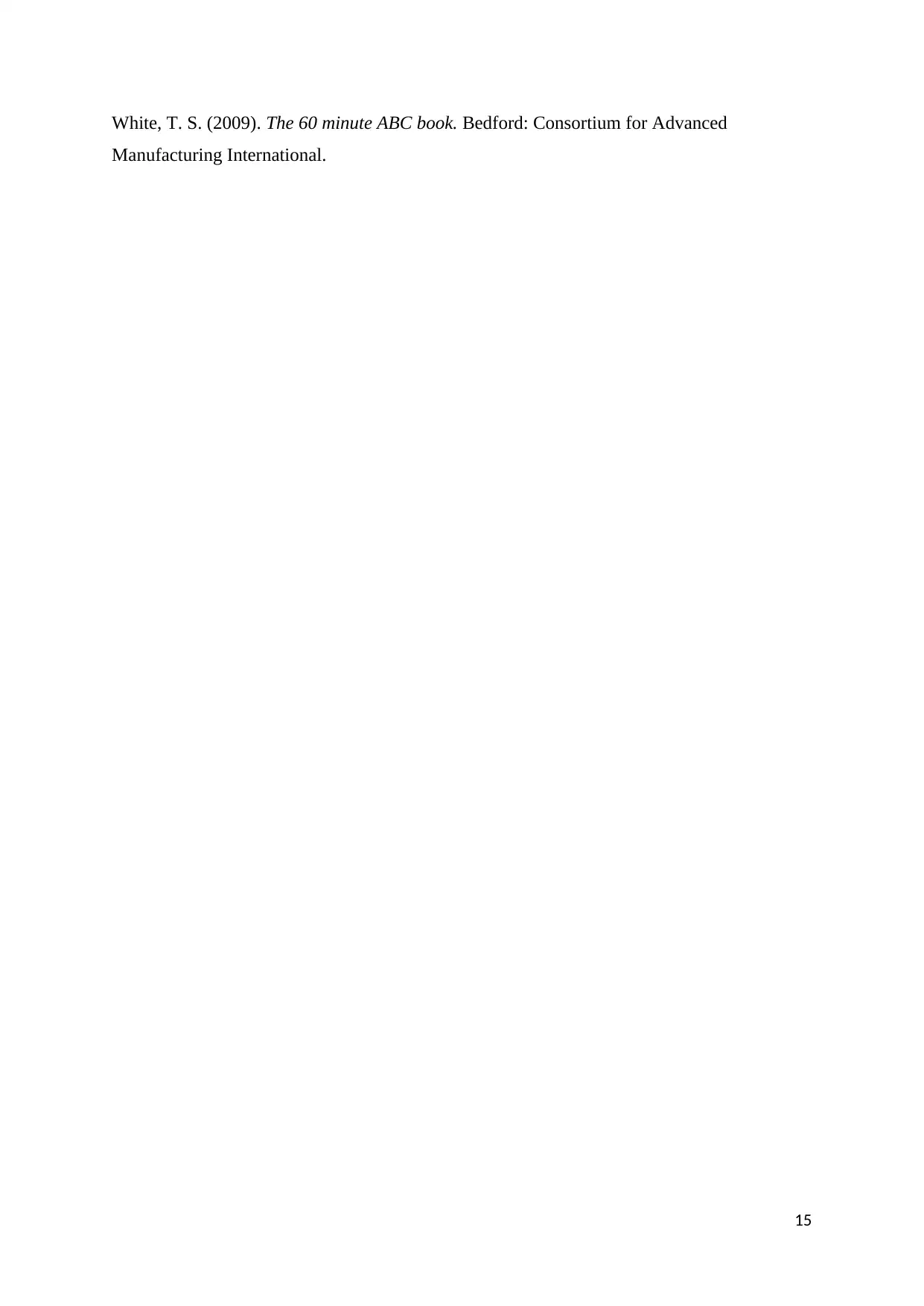
White, T. S. (2009). The 60 minute ABC book. Bedford: Consortium for Advanced
Manufacturing International.
15
Manufacturing International.
15
You're viewing a preview
Unlock full access by subscribing today!
1 out of 15
Related Documents
Your All-in-One AI-Powered Toolkit for Academic Success.
+13062052269
info@desklib.com
Available 24*7 on WhatsApp / Email
![[object Object]](/_next/static/media/star-bottom.7253800d.svg)
Unlock your academic potential
© 2024 | Zucol Services PVT LTD | All rights reserved.





